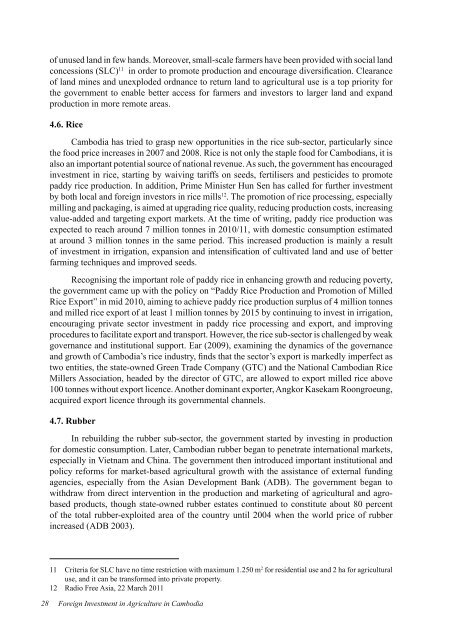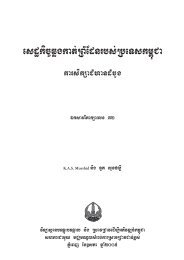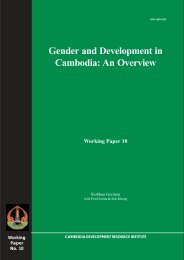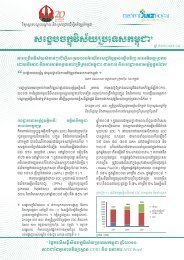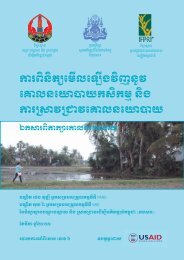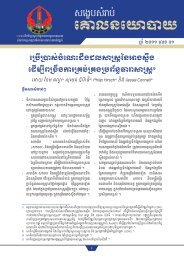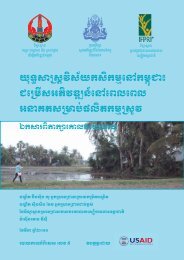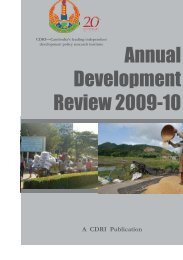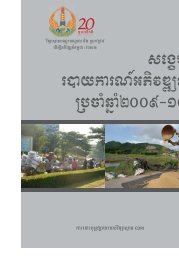Foreign Investment in Agriculture in Cambodia CDRI Working Paper ...
Foreign Investment in Agriculture in Cambodia CDRI Working Paper ...
Foreign Investment in Agriculture in Cambodia CDRI Working Paper ...
You also want an ePaper? Increase the reach of your titles
YUMPU automatically turns print PDFs into web optimized ePapers that Google loves.
of unused land <strong>in</strong> few hands. Moreover, small-scale farmers have been provided with social land<br />
concessions (SLC) 11 <strong>in</strong> order to promote production and encourage diversification. Clearance<br />
of land m<strong>in</strong>es and unexploded ordnance to return land to agricultural use is a top priority for<br />
the government to enable better access for farmers and <strong>in</strong>vestors to larger land and expand<br />
production <strong>in</strong> more remote areas.<br />
4.6. Rice<br />
<strong>Cambodia</strong> has tried to grasp new opportunities <strong>in</strong> the rice sub-sector, particularly s<strong>in</strong>ce<br />
the food price <strong>in</strong>creases <strong>in</strong> 2007 and 2008. Rice is not only the staple food for <strong>Cambodia</strong>ns, it is<br />
also an important potential source of national revenue. As such, the government has encouraged<br />
<strong>in</strong>vestment <strong>in</strong> rice, start<strong>in</strong>g by waiv<strong>in</strong>g tariffs on seeds, fertilisers and pesticides to promote<br />
paddy rice production. In addition, Prime M<strong>in</strong>ister Hun Sen has called for further <strong>in</strong>vestment<br />
by both local and foreign <strong>in</strong>vestors <strong>in</strong> rice mills 12 . The promotion of rice process<strong>in</strong>g, especially<br />
mill<strong>in</strong>g and packag<strong>in</strong>g, is aimed at upgrad<strong>in</strong>g rice quality, reduc<strong>in</strong>g production costs, <strong>in</strong>creas<strong>in</strong>g<br />
value-added and target<strong>in</strong>g export markets. At the time of writ<strong>in</strong>g, paddy rice production was<br />
expected to reach around 7 million tonnes <strong>in</strong> 2010/11, with domestic consumption estimated<br />
at around 3 million tonnes <strong>in</strong> the same period. This <strong>in</strong>creased production is ma<strong>in</strong>ly a result<br />
of <strong>in</strong>vestment <strong>in</strong> irrigation, expansion and <strong>in</strong>tensification of cultivated land and use of better<br />
farm<strong>in</strong>g techniques and improved seeds.<br />
Recognis<strong>in</strong>g the important role of paddy rice <strong>in</strong> enhanc<strong>in</strong>g growth and reduc<strong>in</strong>g poverty,<br />
the government came up with the policy on “Paddy Rice Production and Promotion of Milled<br />
Rice Export” <strong>in</strong> mid 2010, aim<strong>in</strong>g to achieve paddy rice production surplus of 4 million tonnes<br />
and milled rice export of at least 1 million tonnes by 2015 by cont<strong>in</strong>u<strong>in</strong>g to <strong>in</strong>vest <strong>in</strong> irrigation,<br />
encourag<strong>in</strong>g private sector <strong>in</strong>vestment <strong>in</strong> paddy rice process<strong>in</strong>g and export, and improv<strong>in</strong>g<br />
procedures to facilitate export and transport. However, the rice sub-sector is challenged by weak<br />
governance and <strong>in</strong>stitutional support. Ear (2009), exam<strong>in</strong><strong>in</strong>g the dynamics of the governance<br />
and growth of <strong>Cambodia</strong>’s rice <strong>in</strong>dustry, f<strong>in</strong>ds that the sector’s export is markedly imperfect as<br />
two entities, the state-owned Green Trade Company (GTC) and the National <strong>Cambodia</strong>n Rice<br />
Millers Association, headed by the director of GTC, are allowed to export milled rice above<br />
100 tonnes without export licence. Another dom<strong>in</strong>ant exporter, Angkor Kasekam Roongroeung,<br />
acquired export licence through its governmental channels.<br />
4.7. Rubber<br />
In rebuild<strong>in</strong>g the rubber sub-sector, the government started by <strong>in</strong>vest<strong>in</strong>g <strong>in</strong> production<br />
for domestic consumption. Later, <strong>Cambodia</strong>n rubber began to penetrate <strong>in</strong>ternational markets,<br />
especially <strong>in</strong> Vietnam and Ch<strong>in</strong>a. The government then <strong>in</strong>troduced important <strong>in</strong>stitutional and<br />
policy reforms for market-based agricultural growth with the assistance of external fund<strong>in</strong>g<br />
agencies, especially from the Asian Development Bank (ADB). The government began to<br />
withdraw from direct <strong>in</strong>tervention <strong>in</strong> the production and market<strong>in</strong>g of agricultural and agrobased<br />
products, though state-owned rubber estates cont<strong>in</strong>ued to constitute about 80 percent<br />
of the total rubber-exploited area of the country until 2004 when the world price of rubber<br />
<strong>in</strong>creased (ADB 2003).<br />
11 Criteria for SLC have no time restriction with maximum 1.250 m 2 for residential use and 2 ha for agricultural<br />
use, and it can be transformed <strong>in</strong>to private property.<br />
12 Radio Free Asia, 22 March 2011<br />
28 <strong>Foreign</strong> <strong>Investment</strong> <strong>in</strong> <strong>Agriculture</strong> <strong>in</strong> <strong>Cambodia</strong>


